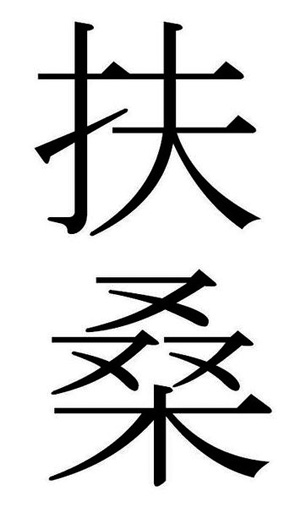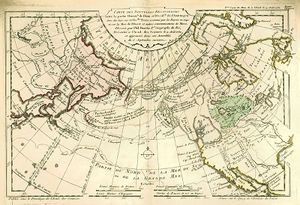Fusang
Diese Seite ist noch in Arbeit!
Inhaltsverzeichnis
Ein myseriöses Land im Osten Chinas
(red) Fusang oder Fousang (扶桑, Mandarin Pīnyīn: fúsāng) ist ein legendäres Land, welches im Jahr 499 n. Chr. von dem buddhistischen Reisenden und Missionar Hui Shen (慧深; Mandarin Pīnyīn: huìshēn) beschrieben wurde. [1] Es soll 20.000 chinesische li (ca. 7000 bis 10.000 Kilometer, abhängig von der Definition des li) östtlich von Da-han, und auch im Osten Chinas gelegen haben. Da-han is described as a place north-east of the country of Wo (southwestern Japan). Hui Shen went by ship to Fusang, and upon his return reported his findings to the Chinese Emperor. His descriptions are recorded in the 7th century Book of Liang (History of the Liang Dynasty) by Yao Silian.
An earlier account, from the annals of the Han dynasty, also declares that in 219 BCE emperor Shi Huang sent "an expedition of young men and women to a wonderful country lying far off to the east, across the ocean, called Fu-Sang. The young people settled there and were happy".
Beschreibungen von Fusang
According to the report of Hui Shen to the Chinese during his visit to China, described in the Liang Shu:
"Fusang is 20,000 li to the East of the country of Dàhàn (lit. 'Great Han'), and located to the east of China (lit. 'Middle Country')." "On that land, there are many Fusang plants (perhaps red mulberry) that produce oval-shaped leaves similar to paulownia and edible purplish-red fruits like pears. The place was rich in copper and traces of gold and silver but no iron. The native tribes in Fusang were civilized, living in well-organized communities. They produced paper from the bark of the Fusang plants for writing and produced cloth from the fibers of the bark, which they used for robes or wadding. Their houses or cabins were constructed with red mulberry wood. The fruits and young shoots of the plants were one of their food sources. They raised deer for meat and milk, just as the Chinese raised cattle at home, and produced cheese with deer milk. They traveled on horseback and transported their goods with carts or sledges pulled by horses, buffalo, or deer." (Liang Shu, in Lily Chow)
On the organization of the country:
"An emperor, or a main chief, with the help of several officials, governed the country. The majority of people were law-abiding citizens. The country had no army or military defense but two jails, one in north and the other in south of the country. Those who had committed serious crimes were sent to the north and they stayed there for their entire lives. These inmates, however, could get married. If they got married and produced children, their sons became slaves and daughters remained as maids" (Liang Shu, in Lily Chow)
On the social practices:
"The marriage arrangement was relatively simple. If a boy wanted to marry a girl, he had to build a cabin next to the home of the girl and stay there for a year. If the girl liked him they would get married; otherwise he would be asked to go away.…When a person died in the community his body would be cremated. The mourning period varied from seven days for the death of a parent to five days for a grandparent and three days for a brother or sister. During their mourning period they were not supposed to consume food, only water. They had no religion." (Liang Shu, in Lily Chow)
The Liang Shu also describes the conversion of Fusang to the Buddhist faith by five Buddhist monks from Gandhara:
"In former times, the people of Fusang knew nothing of the Buddhist religion, but in the second year of Da Ming of the Song dynasty (485 CE), five monks from Kipin (Kabul region of Gandhara) travelled by ship to that country. They propagated Buddhist doctrine, circulated scriptures and drawings, and advised the people to relinquish worldly attachments. As a result, the customs of Fusang changed".
Zwei Modelle zur Lokalisierung
Eastern Japan
A common interpretation of the term "Fusang" is Japan, although in Hui-Sheng's report Fusang is presented as distinct from the statelet of Wo, another name associated with ancient Japan and probably could have been describing Japanese communities in the island of Kyūshū or Ryukyu Kingdom.[citation needed]
In Chinese mythology, Fusang refers to a divine tree in the East, from where the sun rises. A similar tree, known as Ruomu exists in the west, and each morning the sun was said to rise from Fusang and fall on Ruomu. Chinese legend has ten birds (typically ravens) living in the tree, and as nine rested, the tenth would carry the sun on its journey. This legend has similarities with the Chinese tale of the fictional hero Houyi, sometimes referred to as the Archer, who is credited with saving the world by shooting down nine of the suns when one day all ten took to the air simultaneously. Some scholars have identified the bronze trees found at the archaeological site Sanxingdui with these Fusang trees. The term Fusang would later designate Japan in Chinese poems.[citation needed]
Fusang is pronounced Fusō (扶桑) in the Japanese language, and is one of the names to designate ancient Japan. Several warships of the Imperial Japanese Navy were named Fusō (the ironclad Fusō, or the World War II battleship Fusō). Several companies, such as Mitsubishi Fuso Truck and Bus Corporation also bear the name.
The Americas
According to some historians since the work of Joseph de Guignes (Le Fou-Sang des Chinois est-il l'Amérique? Mémoires de l'Académie des Inscriptions et Belles Lettres, tome 28, Paris, 1761), the distances given by Hui Shen (20,000 Chinese li) would locate Fusang on the west coast of the American continent, when taking the ancient Han-period definition of the Chinese li. Some 18th century European maps locate Fusang north of the State of California, in the area of British Columbia.
The Chinese li, or Chinese mile unit of distance, varied through time. It was roughly 435 meters during the Chin and Han dynasties. With the Han li, the 20,000 li distance would translate into about 8,700 kilometers, a close approximation of the distance between China and British Columbia (8,600 kilometers).
Externa
Charles G. Leland, FUSANG - The Discovery of America by Chinese Buddhist Priests in the Fifth Century (1875)
Anmerkungen und Quellen
Dieser Beitrag basiert weitgehend auf dem Artikel "Fusang" bei Wikipedia - The Free Encyclopedia (Stand: 01.03.2010). Übersetzung ins Deutsche und umfassende redaktionelle Bearbeitung durch Atlantisforschung.de
- ↑ Siehe: 《梁書•諸夷列傳》(Collective Biographies of Foreign Countries,Book of Liang): 扶桑國者,齊永元元年,其國有沙門慧深來至荊州,说云:“扶桑在大漢國東二萬餘里, (...)” (The country of Fusang, in the year Yong-yuan 1 of the Qi Dynasty, a Shramana monk from there called Hui Shen came to Jingzhou, and said: "Fusang is 20,000 li to the East of the country of Dàhàn,(...)"
Bild-Quelle
(1-3) Wikipedia - The Free Encyclopedia, unter: Fusang


